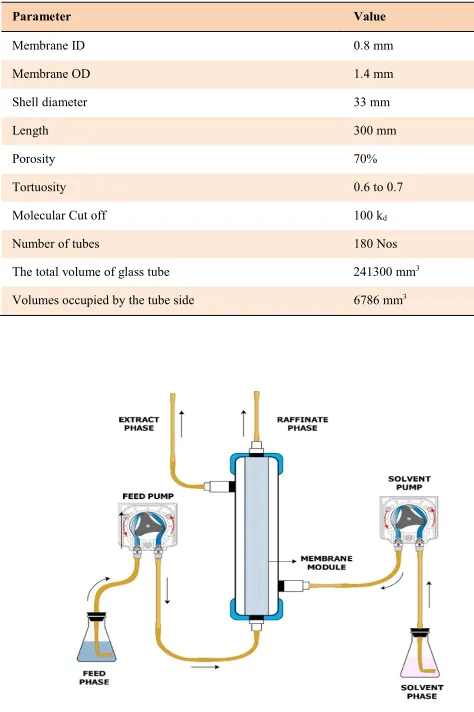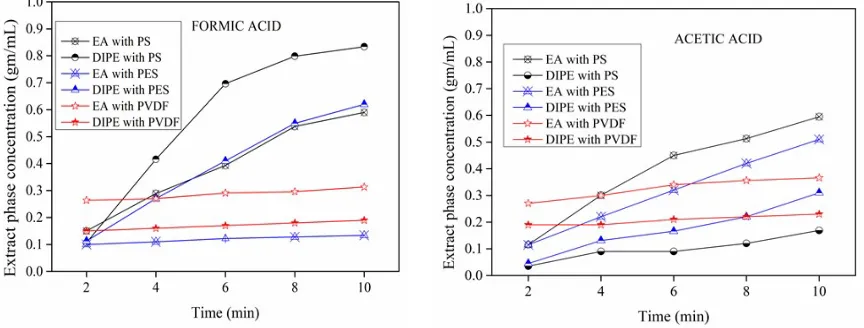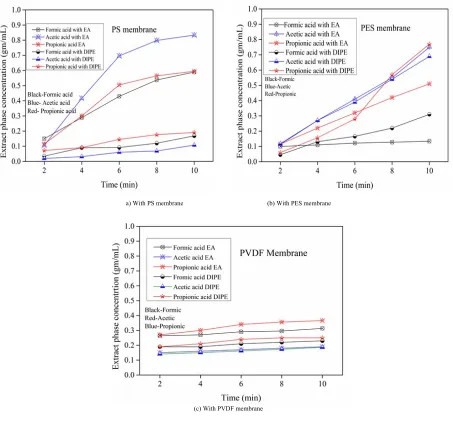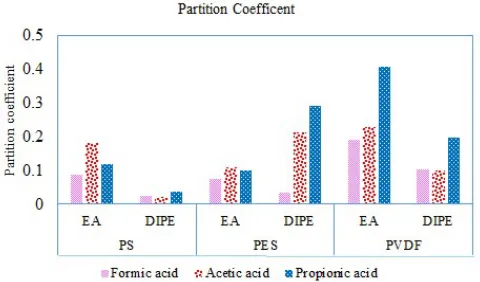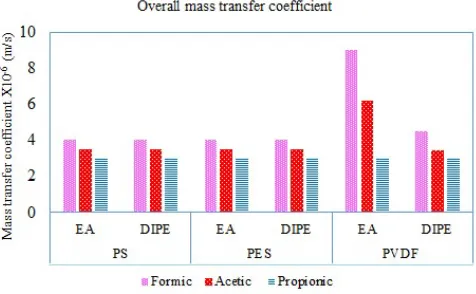Keywords
Highlights
Abstract
Graphical abstract
233
Research Paper
Received 2018-06-25 Revised 2018-08-09 Accepted 2018-08-29 Available online 2018-08-29
Carboxylic acids PVDF PES PS membrane Partition coefficient
• Three different membrane contactors for separation of carboxylic acids • Performance of membrane modules obtained in the range of
PS=PES<PVDF
• Solute-extractant-membrane interactions would play an essential role
Separation of Carboxylic Acids from Aqueous Solutions using Hollow Fiber Membrane
Contactors
Department of Chemical Engineering, SRM Institute of Science and Technology, Kattankulathur- 603203, Tamil Nadu, India
K. Sofiya
*, E. Poonguzhali, Ashish Kapoor, Philip Delfino, S. Prabhakar
Article info
© 2019 MPRL. All rights reserved.
* Corresponding author at: Phone: 9443562721
E-mail address: ksofiya26@yahoo.co.in; sofiya.k@ktr.srmuniv.ac.in (K. Sofiya)
DOI: 10.22079/JMSR.2018.88804.1199
1. Introduction
Mitigation of environmental pollutants particularly organic contaminants is a challenging task. Aqueous waste streams containing organic components, such as carboxylic acids are of increasing environmental concern. Separation of the carboxylic acids from aqueous solutions is desirable both regarding the environmental concerns and economics. The three primary carboxylic acids namely formic, acetic, and propionic acids are involved in many core chemical engineering industrial processes as the primary raw materials. These monocarboxylic acids are produced relatively significant amount as stable oxidation products through the synthesis of chemical reactions or by fermentation processes, although the concentration are found to depend on the type of operation used [1-4]. A wide variety of industries, including textile, printing, dyeing, tanning, rubber processing, polymer, paints, electroplating uses the carboxylic acids. Fungicide manufacturing, food processing, medicinal
and pharmaceuticals incorporate these carboxylic acids in their production processes at various stages [5-8]. Extensive usage of these chemicals is accompanied by their residual amounts in the effluent process streams. Several methods to remove and recover carboxylic acids from the aqueous solutions, including the conventional techniques such as precipitation, adsorption, distillation, solvent extraction, and reactive extraction, etc., have been studied. However, each of the methods poses several challenges. In adsorption based systems, it is not always easy to identify the breakthrough point besides the regeneration challenge of the bed. Distillation is energy intensive process relying on the difference in the relative volatility of the components, which are more often not conducive. Further, the boiling points of some of the carboxylic acids are more than water, and it results in economically unfavorable water evaporation [9].
Journal of Membrane Science & Research
journal homepage: www.msrjournal.com
Separation of formic, acetic, and propionic acids from the aqueous stream using membrane solvent extraction has been studied using three different membrane contactors made of polysulfone (PS), polyethersulfone (PES), and polyvinylidene fluoride (PVDF) using two different solvents; including ethyl acetate (EA) and diisopropyl ether (DIPE). The efficiency of the membrane and extractants were obtained by partitioning coefficient comparison. The overall mass transfer coefficient was determined by resistance in series model. The results indicated significant difference amongst the performance of the membranes for the same system, even though one usually would expect the membrane only to play a role in facilitating high interfacial mass transfer contact area. The observable results of high distribution coefficient were obtained for the propionic acid with the PVDF membrane and EA as an extractant, on the other hand, the formic acid with PVDF and EA as extractants obtained a better mass transfer coefficient of 9×10-6 m/s.
Precipitation methods involve the use of lime to produce the corresponding calcium salt [8]. Its limitation includes cost concerns, high chemical consumption, low yields and the sludge disposal. Conventional solvent extraction methods are emulsion based and rely on density differences between the phases for reasonable separation. Considering the energy requirements involved, reactive distillation and other distillation methods are economical at higher capacities.
Membrane processes offer the opportunity to perform same separations while bypassing the constraints. In the present scenario, the use of membrane contactor for removal of such organic acids has gained increasing interest and attention [10]. The main significant advantages of this hollow fiber membrane methods over the conventional emulsion-based techniques is large contact surface area between the solvent and diluent phase provided by the microporous hollow fiber contactor. Furthermore, this technique offers additional merits, including independence of the flow rates in reducing loading and flooding, dispersion-free operation, modular design, ease of scale-up, retrofitting of equipment, and no requirement of any density difference between the phases. The compactness and the rate governed features of the membrane contactors with hollow fiber have been the reason for its increasing usage [11-14].
Some research have been reported in the literature on membrane contactors [10-14] for the removal of organics acids. Removal of carboxylic acids such as the succinic acid [15], the valeric acid [12], the heterocyclic carboxylic acids [16] and others are also reported [17-19]. The acetic acid removal was also studied by some of researchers [20-24]. The performance of hydrophobic membranes for acetic acid separation using methyl isobutyl ketone (MIBK), and xylene [23] as extractants with hydrophilic composite membranes [22] were also reported in the literature [13, 18-22, 25-29].
The focus of the present study is to investigate the performance of different membrane modules for extraction of commonly used primary carboxylic acids namely the formic acid, the acetic acid, and the propionic acid from their aqueous forms. Three high molecular weight polymeric membrane contactors used in this study are polysulfone (PS), polyethersulfone (PES) and polyvinylidene fluoride (PVDF). The selection of membranes was based on their chemical, mechanical and thermal stability and established usage in environment, industry and allied applications. Ethyl acetate (EA) and diisopropyl ether (DIPE) were designated as the extractants due to their compatibility with the membranes and environmentally friendly nature. The performance of all three membranes was examined by obtaining the partitioning coefficient, which is determined by the equilibrium slope methods and the overall mass transfer coefficient. The overall mass transfer coefficient was obtained by using the resistance in series model.
2. Materials and Methods
2.1.Materials
The three hollow fiber membrane modules PS, PES and PVDF were obtained from Tech Inc. (Chennai, India). Formic acid (98-100%), and acetic acid (glacial) were supplied by Rankem (Chennai, India). Propionic acid, ethyl acetate, and diisopropyl ether (all extra pure AR) were sourced from Sri Chem. (Chennai, India).
2.2.Methods
The schematic view of the experimental setup is given in Figure 1. The experiments were carried out in three different membrane modules of PS, PES, and PVDF with similar geometrical characteristics that are shown in Table 1. Initial screening experiments were performed to ensure compatibility of membranes with reagents. The membrane module was arranged in a vertical position with the co-current operation. The aqueous feed of 5% (vol%) of primary carboxylic acids, viz formic, acetic and propionic acids were produced synthetically by diluting the acids in distilled water and circulated into the tubes side.
This work is directed on the dilute concentration of acids which is selected based on the typical scenario of the effluent process streams and compatibility with the membrane modules. The solvents ethyl acetate and diisopropyl ether were circulated into the shell side without dilution. The feed and extractant phase was circulated by using the peristaltic pump, with the flow rates of 7ml/min in both the shell and tube side. The concentration of acids in the extract phase and raffinate phase was analyzed by acid-base titration using NaOH with phenolphthalein as an indicator when diisopropyl ether was a solvent [1, 4, 6, 23, 31, 32]. The potentiometric titration method was used when ethyl acetate was a solvent [33].
2.3. Theory
Membrane contactor is a device having the very high interfacial area in the form of the microporous membrane that allows the solute to pass through it to the organic phase without the intimate contact between the phase streams (Figure 2).
Table 1
Specifications of the PVDF, PES, and PS membrane modules.
Fig. 1. Experimental Schematic diagram for the membrane solvent extraction setup.
Fig. 2. Principles of the membrane solvent extraction process.
Parameter Value
Membrane ID 0.8 mm
Membrane OD 1.4 mm
Shell diameter 33 mm
Length 300 mm
Porosity 70%
Tortuosity 0.6 to 0.7
Molecular Cut off 100 kd
Number of tubes 180 Nos
The total volume of glass tube 241300 mm3
The mass transfer in the membrane contactor based extraction systems can be compared with the three subsequent steps, which are in turn responsible for the prediction of overall mass transport coefficient. The steps involved are i) mass transfer from the aqueous phase to the interfacial of the membrane ii) diffusion through the porous membrane, and iii) diffusion to the organic phase. The overall mass transfer coefficient can be estimated through the following equation for no chemical reaction [20, 26, 27, 34, 35, and 36].
o w
i
m i
os i
w
k
d
d
d
k
d
k
m
K
ln
1
1
(1)
The study of a mass transfer behavior of feed side, solvent side and on the membrane, was critical. The coefficient of mass transfer on the pores of the membrane (km) may be taken from the Fick’s first law as a function of the
coefficient of diffusion of the solute in pores and membrane characteristics such as the density, porosity, and tortuosity of the membrane. The value of km used in this study is obtained using the following expression [11, 27].
t
D
k
m
(2)In the present work, the diffusivity based on solute D=5.145 x 10-7m2s-1 is
determined at 296K using Wilke Lee and Chang method. The membrane porosity is 0.35 and tortuosity is 2.5 as per data from the vendor.
2.3.1. Prediction of Individual mass transfer coefficient on shell and tube
The individual mass transfer coefficients kw and kos depend on the characteristics of the fluid and flow conditions. The movement through the membrane is reasonably assumed to be always under laminar conditions. The tube and shell side mass transfer coefficients are dependent on the fluid
velocity. Leveque suggested that the following equation can be used to evaluate the tube side mass transfer coefficient when the Graetz number (Gz) greater than 4 [1, 27].
33 . 0 2
62 .
1
tin t tube
d D k
(3)
The mass transfer coefficients of the shell side in the membrane module can be predicted by taking the relationship among the dimensionless groups. It can be expressed as follows:
dh
Sc
D
dh
k
Sh
shells ex
shell
(
1
)
Re
0.6 0.33 (4)where β (correlation constant) is 6.1 for hydrophilic membranes and 5.8 for hydrophobic membrane [28], the Reynolds number value lies in the range 0 < NRe < 500 and 0.04 < φ < 4. In the present study, both the conditions are satisfied as Reynolds number range from 1.17 to 490, and φ = 0.10. Reynolds number over the tube portion was observed to vary from 81 to 490, and the shell side portion varied in the range between the values of 1.17 to 3, it indicates the laminar conditions of the present study.
3. Results and discussion
3.1. Extract phase concentrations
The Figures 3a-c, indicate the extraction phase concentration of the carboxylic acid concentration as a function of the time.
(a) Formic acid with PS, PES and PVDF membrane (b) Acetic acid with PS, PES and PVDF membrane
(c) Propionic acid with PS, PES and PVDF membrane (Black-PS, Blue-PES, Red-PVDF)
a) With PS membrane (b) With PES membrane
(c) With PVDF membrane
Fig. 4. Theextract phase concentration of the formic, acetic and propionic acids with time a) the PS membrane b) the PES membrane c)and the PVDF membrane.
The performance of three membrane modules PS, PES, and PVDF with the two extractants namely ethyl acetate and diisopropyl ether for the separation of three carboxylic acids (formic, acetic, and propionic acid) are summarized with the data in the above plots. Figure 3 explains the carboxylic acid concentration obtained in the solvent phase with time for the individual acids. The extraction phase concentration (mg/mL) was found to be higher for DIPE as a solvent for the formic acid with the PS membrane, and EA obtained the higher concentration for the acetic acid and the propionic acid with the PS and PES membranes. The constancy of the extract phase concentration with respect EA as the solvent indicates that the membrane resistant for the mass transfer nearly negligible and is mainly controlled by the affinity of the solvent which appears to be less compared to EA. Increased rate of the extractant concentration up to 6 minutes and slow down afterward concerning DIPE as a solvent also indicate that the membrane resistance is not the controlling step but the solvent affinity. Because of the higher affinity initially, the rate of the increase in concentration is high but progressively slows down due to reducing the driving force (concentration difference).
Figures 4a-c give the extraction phase concentration for the three membranes used as a function of time. The plots indicate that the saturation extraction phase concentration under similar operating conditions is maximum in the order of PS > PES > PVDF irrespective of feed composition. It can be observed that at the initial stages the extraction is steady for PVDF compared to PS and PES. Later there is no noticeable increase in the concentration either for PVDF suggesting that it is steady and fast but not efficient. For the PS and PES membranes the extraction is more significant with time.
Comparison of extraction of carboxylic acids:
1. Among the three acids studied formic acid is relatively less extracted compared to acetic acid in all the cases. This may be attributed to low molecular exists in formic acid or the further investigation needed. 2. Acetic acid is relatively extracted more compared to propionic acid when
PS or PES membrane is used.
3. PVDF membrane exhibits a different trend with the higher extraction of propionic acid compared to acetic acid.
Based on the above observations it is probable that the nature of the membrane has a role to play. Relatively PVDF is hydrophobic while PS and PES are more towards the hydrophilic side. More experimental investigations are required to confirm the role of the membrane characteristics. The widespread belief that the membrane matrix is an inert medium in membrane contactors (excepting for the wetting nature) may have to be revisited, particularly in the context of industrial separations.
3.2. Partition coefficient
(a) With PS membrane (b) With PES membrane
(c) With PVDF membrane
Fig. 5. Partition coefficient of formic, acetic, and propionic acids using EA and DIPE as a solvent a)PS membrane, b) PES membrane, c) PVDF membrane.
The highest partition coefficient obtained for the acetic acid with EA as an extractant was obtained for the PS membrane. Propionic acid achieved the most significant distribution coefficient with the DIPE and PES module. In case of the PVDF membrane, the significant value was obtained for the propionic acid with EA as an extractant. The consolidated partition coefficient data from Figure 5 is shown in that Figure 6.
Fig. 6. Partition coefficient of the formic, acetic and propionic acids.
The performance of these two extractants on the PS membrane showed that the trends of concentration of the acetic acid present in the ethyl acetate phase were higher for the ethyl acetate phase and lower for the diisopropyl ether phase. The propionic acids showed the highest extract phase concentration in the diisopropyl ether phase with the both PS and PES membranes. The performance of the PVDF membrane using the two extractants showed good results for the propionic acid in comparison with the formic and acetic acids. The performance of the PVDF membrane noted in the order of propionic>formic>acetic acids. The results conclude that for the acetic acid separation with the PS and PES membrane showed better results with the ethyl acetate as the extractant, on the other hand for the propionic acid the PVDF membrane with both extractants showed the better results. In case of the PES membrane, the extractant DIPE obtained the better performance than the EA one.
3.3. Overall mass transfer coefficient
obtained in the range of PS=PES<PVDF. The overall mass transfer coefficient diverse from 4×10-6 to 9×10-6 m/s in the present study. These
values are in the same range of the previous literatures. Recovery of the vanillin from the ferulic acid obtained the mass transfer coefficient of 1.3×10 -5 (m/s) [25]. Removal of p-nitrophenol from aqueous solutions with the value
of 6.5×10-6 (m/s) [26], Pierre and Souchon [37] obtained the values of 5×10-6
to 3×10-5 (m/s) and recovery of the sulfur from aqueous solutions with the
overall mass transfer coefficient of 6.2×10-7 (m/s).
4. Conclusions
Performance studies of three different membrane modules with two different extractants (ethyl acetate and diisopropyl ether) for the separation of the primary carboxylic acids namely, the formic, acetic, and propionic acids were conducted. It was observed from the results that the continuous separation of carboxylic acids from their aqueous forms was possible by using the PS, PES, and PVDF membranes. The high concentration was obtained as 0.85gm/mL in PS membrane for the acetic acid separation. Even though the PS and PES membranes obtained higher concentration, the PVDF membrane gave slightly better partition coefficient. In comparison with the extractants, the ethyl acetate served as a better extractant. The high partition coefficient of 0.4 was obtained for the propionic acid with the PVDF membrane. The most top mass transfer coefficient was obtained for the propionic acid with the PVDF module. The overall performance results indicate that for the formic acid, acetic acid and, the PS and PES membranes may serve as a suitable membrane contactor and for the propionic acid, the PVDF module may give better performance. The essential learning of the study is that the membrane
used for the solvent extraction process influences the separation performance. It opens a new arena to explore the separation phenomena in which the solute-extractant-membrane interactions would play an essential role in determining the mass transport. The insights gained would pave the way for designing selective and efficacious membrane-based separation systems.
Fig. 7. The overall mass coefficient of the formic, acetic and propionic acids.
Nomenclature
mi Distribution coefficient
Kw Overall mass transfer coefficient based on aqueous phase concentration (m/s)
kw Individual mass transfer coefficient on aqueous phase (m/s)
kos Individual mass transfer coefficient on solvent phase (m/s)
Km Mass transfer coefficient on membrane
Di Tube inner diameter (m)
Do Tube outer diameter (m)
dln logarithmic mean diameter (m)
D Diffusivity (m2/s)
ɛ Membrane porosity τ Membrane tortuosity
t Thickness of the membrane (m)
Dt Diffusion coefficient of the solute on the tube side (m2/s)
Υ Fluid velocity (m/s) ᶩ Length of fiber (m)
dtin Internal diameter of the hollow fiber membrane (m)
Dh hydraulic diameter (m)
Φ Module packing density NRe Reynolds number
Sc Schmidt number
Sh Sherwood number
β Constant
References
[1] M. Wisniewski, M. Pierzchalska, Recovery of carboxylic acids C1-C3 with organo phosphine oxide solvating extractants, J. Chem.Technol Biotechnol. 80 (2005) 1425-1430.
[2] M.N. Ingale, V.V. Mahajani, Recovery of carboxylic acids, C2-C6, from an aqueous waste stream using tributylphosphate (TBP): Effect of presence of inorganic acids and their sodium salts, Sep. Tech. 6 (1992) 1-7.
[3] M.N. Ingale, V.V. Mahajani, Recovery of acetic acid and propionic acid from aqueous waste stream, Sep. Technol. 4 (1994) 123-126.
[4] M. Rodriguez, M.J. Gonzalez-Munoz, S. Luque, J.R. Alvarez, J. Coca, Extractive ultrafiltration for the removal of carboxylic acids, J. Membr. Sci. 274 (2006) 209-218.
[5] W. Cai, S. Zhu, X. Piao, Extraction equilibria of formic and acetic acids from aqueous solution by phosphate –containing extractants, J. Chem. Eng. Data 46 (2001) 1472-1475.
[6] N.D. Patil, A.W. Patwardhan, A.V. Patwardhan, Carboxylic acids separation using hollow fiber supported liquid membrane, Indian J. Chem. 24 (2017) 20-31. [7] A. Keshav, S. Chand, K.L. Wasewar, Recovery of propionic acid from aqueous
phase by reactive extraction using quaternary amine (Aliquat 336) in various diluents, Chem. Eng. J. 152 (2009) 95-102.
[8] A. Keshav, K.L. Wasewar, Back extraction of propionic acid from loaded organic phase, Chem. Eng. Sci. 65 (2010) 2751-2757.
[9] Y.K. Hong, W.H. Hong, Y.K. Chang, Effect of pH on the extraction characteristics of succinic and formic acids with tri-n-octylamine dissolved with 1- octanol, Biotechnol. Bioprocess Eng. 6 (2001) 347-351.
[10] G.K. Agrahari, N. Pandey, N. Verma, P.K. Bhattacharya, Membrane contactor for reactive extraction of succinic acid from aqueous solution by tertiary amine, Chem. Eng. Res. Des. 92 (2014) 2705-2714.
[11]R. Gawronski, B. Wrzesinska, Kinetics of solvent extraction in hollow-fiber contactors, J. Membr. Sci. 168 (2000) 213-222.
[12]M. Rodriguez, R.M.C. Viegas, S. Luque, I.M. Coelhoso, J.P.S.G. Crespo, J.R. Alvarez, Removal of valeric acid from wastewaters by membrane contactors, J. Membr. Sci. 137 (1997) 45-53.
[13] K. Soldenhoff, M. Shamieh, A. Manis, Liquid-liquid extraction of cobalt with hollow fiber contactor, J. Membr. Sci. 252 (2005) 183-194.
[14] G.D. Bothun, B.L.Knutson, H.J. Stobel, S.E. Nokes, Mass transfer in hollow fiber membrane contactor extraction using compressed solvents, J. Membr. Sci. 227 (2003) 183-196.
[15] L.S. Moraes, F.A. Kronemberger, H.C. Ferraz, A.C. Habert, Liquid-liquid extraction of succinic acid using a hollow fiber membrane contactor, J. Ind. Chem. 21 (2014) 206-211.
[16] L. Kubisov, E. Sabolova, S. Schlosser, J. Mart, R. Kertesz, Membrane based solvent extraction and stripping of a heterocyclic carboxylic acid in hollow fiber contactors, Desalination 148 (2002) 205-211.
[17]D.W. Choi, Y.H. Kim, Cadmium removal using hollow fiber membrane with organic extractant, Korean J. Chem. Eng. 20 (2003) 768-771.
[18] R. Prasad, K.K. Sirkar, Hollow fiber solvent extraction of pharmaceutical products: A case study, J. Membr. Sci, 47 (1989) 235-259.
[19] P.R. Alexander, R.W. Callahan, Liquid-liquid extraction and stripping of gold with microporous hollow fiber m, J. Membr. Sci. 35 (1987) 57-71.
[20]D.L. Grzenia, D.J. Schell, S.R. Wickramasinghe, Membrane extraction for acetic acid from biomass hydrolysates, J. Membr. Sci, 322 (2008) 189-195.
[21] N.A. Delia, L. Dahuron, E.L. Cussler, Liquid-liquid extraction with microporous hollow fiber, J. Membr. Sci. 29 (1986) 309-319.
[22]R. Prasad, A. Kiani, R.R. Bhave, K.K. Sirkar, Further studies on solvent extraction with immobilized interfaces in a microporous hydrophobic membrane, J. Membr. sci. 26 (1986) 76-97.
[23]A. Kiani, R.R. Bhave, K.K. Sirkar, Solvent extraction with immobilized interfaces in a microporous hydrophobic membrane, J. Membr. Sci. 20 (1984) 125-145. [24]R. Prasad, K.K. Sirkar, Solvent extraction with microporous hydrophilic and
composite membrane, AIChE.33 (1987) 1057-1066.
[25] L. Sciubba, D.D. Gioia, C. Gostoli, Membrane –based solvent extraction of vanillin in hollow fiber contactor, Desalination 241 (2009) 357-364.
[26]C.J. Tompkins, A.S. Michales, S.W. Peretti, Removal of p-nitro phenol from aqueous solution by membrane-supported solvent extraction, J. Membr. Sci. 75 (1992) 277-292.
membrane –based solvent extraction, J. Membr. Sci. 187 (2001) 239-253. [28]A. Gabelman, S.T. Hwang, Hollow fiber membrane contactors, J. Membr. Sci. 159
(1999) 61-106.
[29] S. Shen, S.E. Kentish, G.W. Stevans, Effects of operational conditions on the removal of phenols from waste water by a hollow-fiber contactor, Sep. Purif. Technol. 95 (2012) 80-88.
[30]H. Huang, S.T. Yang, D.E. Ramey, A hollow- fiber membrane extraction process for recovery and separation of lactic acid from aqueous solutions, Appl. Biochem. Biotechnol. 673 (2004) 113-116.
[31]M.R. Usman, S.N. Hussain, H.M.A. Asghar, H. Sattar, A. Ijaz, Liquid-liquid extraction of acetic acid from an aqueous solution using a laboratory scale sonicator, J. Qual. Technol. Manage. 7 (2011) 115-121.
[32]H. Uslu, Reactive extraction of formic acid by using tri octyl amine (TOA), Sep. Sci. Technol. 44 (2009) 1784-1798.
[33]M. Manteghian, M. Shahbazi, Liquid-liquid equilibrium for the ternary systems of water + acetic acid + ethyl acetate at T=298.2K, Environ. Conserv. 16 (2015) 623-629.
[34] R.S. Juang, H.L. Huang, Mechanistics analysis of solvent extraction of heavy metals in membrane contactors, J. Membr. Sci. 213 (2003) 125-135.
[35]S.B. Iversen, V.K. Bhatia, K. Dam-Johansen, G. Jonsson, Characterization of microporous membranes for use in membrane contactors, J. Membr. Sci. 130 (1997) 205-217.
[36]M.J. Gonzalez-Muno, S. Luque, J.R. Alvarez, J. Coca, Recovery of phenol from aqueous solutions using hollow fiber contactors, J. Membr. Sci. 213 (2003) 181-193.
[37]I. Souchon, F.X. Pierre, S. Sambalt, M. Bes, M. Marin, Recovery of aroma compounds from tomato industry effluent using membrane –based solvent extraction, Desalination 148 (2002) 87-92.
